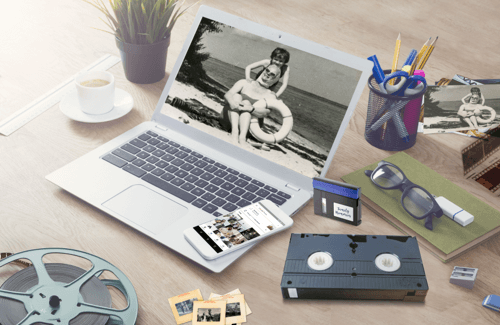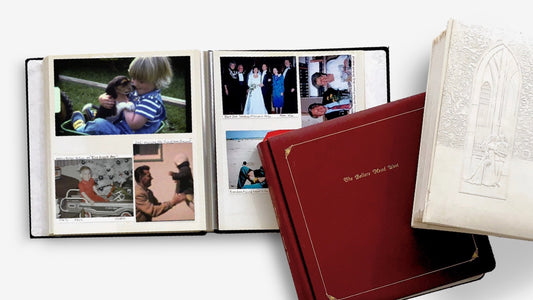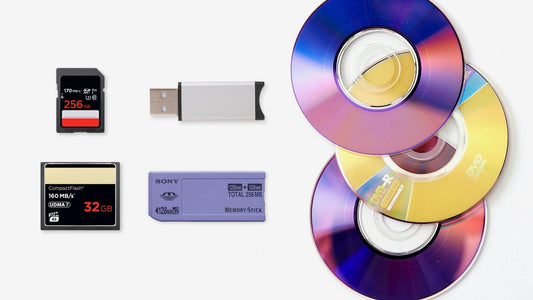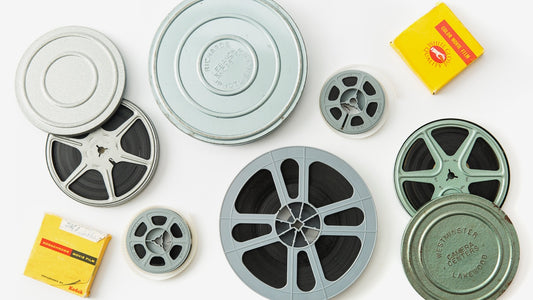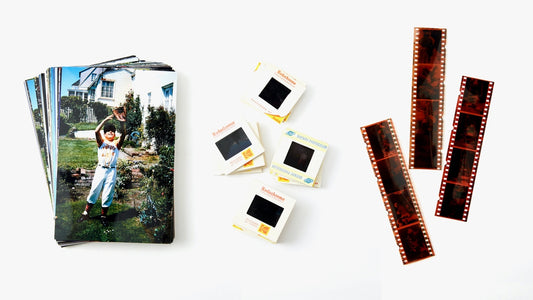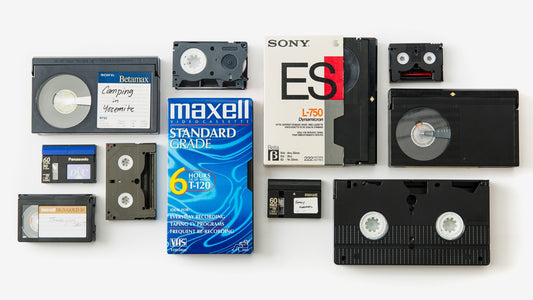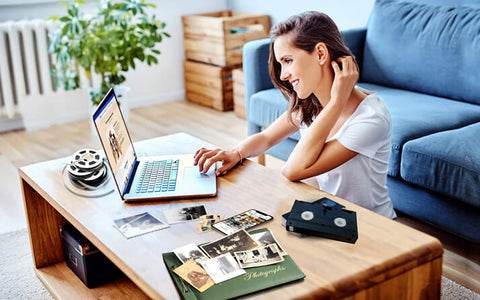You have a stack of Hi8 tapes filled with irreplaceable home movies, but no way to watch them. It’s a common problem, but the real issue isn't just that they're stuck on a shelf. It's that those memories can't be shared or enjoyed right now. The solution is to bring them into the modern age. When you convert Hi8 digital files, you’re not just creating a backup; you’re building a permanent, shareable archive of your family’s history. This article is your complete roadmap. We’ll cover everything from DIY equipment to choosing a professional service, so you can confidently rescue your videos.
Key Takeaways
- Act Now to Save Your Tapes: Hi8 tapes degrade over time, so digitizing them is the only way to stop the decay and protect your home movies from being lost forever.
- Choose Your Conversion Path: You can convert tapes yourself if you have the time and technical comfort, or you can use a professional service for a guaranteed, high-quality result without the hassle.
- Organize and Back Up Your Digital Files: Once your videos are digitized, create a simple folder system and save your files in at least two places (like a cloud service and a thumb drive) to keep them safe and easy to find.
What Are Hi8 Tapes and Why Convert Them to Digital?
If you’ve ever stumbled upon a box of old tapes in your attic or closet, you know that feeling of holding a time capsule in your hands. Many of those tapes from the '80s and '90s are likely Hi8 tapes, filled with irreplaceable moments like birthday parties, family vacations, and school plays. But finding them is just the first step. The real challenge is figuring out how to watch them and, more importantly, how to keep them safe for years to come. Converting your Hi8 tapes to a digital format is the best way to protect those memories from fading away and make them easy to share with everyone you love.
What Exactly Is a Hi8 Tape?
Hi8 tapes were a popular camcorder format that captured countless family memories throughout the 1980s and 1990s. If you have a collection of 8mm tapes, you might have one of three kinds: Video8, Hi8, or Digital8. Hi8 was an improvement on the original Video8 format, offering a sharper, clearer picture. Later, Digital8 arrived, recording a digital signal onto the same style of tape for the highest quality of the three. Understanding which tapes you have is the first step in the preservation process, and a professional video transfer service can handle all of them, ensuring your home movies are in good hands.
Why Your Analog Memories Are at Risk
Those Hi8 tapes are more than just plastic and magnetic strips; they’re your family’s story. Unfortunately, magnetic tapes weren't built to last forever. Over time, they degrade, causing colors to fade, audio to warp, and the picture quality to decline until the memory is lost completely. Digitizing your tapes stops this decay in its tracks. By converting them, you create a permanent, high-quality digital copy that you can watch on any modern device, from your phone to your smart TV. It’s the best way to safeguard your legacy and easily share your cherished memories with family and friends, no matter where they are.
DIY vs. Pro: Which Hi8 Conversion Method Is for You?
When you decide it’s time to bring your Hi8 tapes into the modern era, you have a few paths you can take. The right choice really comes down to your budget, how much time you have, and how comfortable you are with technology. You can handle the project yourself, hand it off to experts, or even find a middle ground that combines a little of both. Let's walk through what each option looks like so you can pick the one that feels right for you and your precious memories.
Going DIY: Converting Tapes on Your Own
If you enjoy a good project and have a bit of technical savvy, the DIY route can be a rewarding experience. This approach gives you complete control over the process from start to finish. The most popular method involves finding a used Digital8 camcorder, as these cameras can play Hi8 tapes and convert the footage to a digital signal directly. You would then connect the camera to your computer using a Firewire cable to capture the video.
Alternatively, you could use a dedicated Hi8 player or a video capture device that connects your old camcorder to your computer via USB. While this path requires an investment in equipment and time to learn the software, it can be cost-effective if you have a large collection of tapes to convert.
Hiring a Pro: Letting Experts Convert Your Tapes
For many people, the easiest and most reliable option is to use a professional conversion service. This is the perfect choice if you’re short on time, worried about damaging your tapes, or simply want the best possible quality without the technical headaches. When you use a service like YesVideo, you’re placing your memories in the hands of trained technicians who handle everything for you.
The process is straightforward: you send in your Hi8 tapes, and the experts use professional-grade equipment to create high-quality digital files. Afterward, you get your original tapes back along with your new digital copies on a thumb drive, DVD, or in the cloud. This method is the most hands-off way to ensure your home movies are preserved safely and effectively.
The Best of Both Worlds: A Hybrid Approach
You don't have to commit to just one method. A hybrid approach can offer a great balance of cost, control, and quality. For example, you might have a few tapes that you’re not overly concerned about and want to use for a trial DIY run. This lets you test the waters and see if you enjoy the process without risking your most cherished memories.
If you find the DIY process too time-consuming or the quality isn't what you hoped for, you can then send your most important tapes to a professional service. This way, you can save a little money on less critical footage while ensuring your most irreplaceable moments, like weddings or a baby’s first steps, receive an expert video transfer. This approach lets you manage your budget while still guaranteeing a professional touch for the memories that matter most.
Gather Your Gear: The DIY Hi8 Conversion Checklist
If you’ve decided to take on the project of converting your Hi8 tapes yourself, the first step is gathering your equipment. Think of it as setting up your own personal memory-saving station. You’ll need a few key pieces of hardware and software to move your home movies from their analog tapes into a digital format. While it can be a rewarding process, it does require some specific gear that you probably don’t have stored in a closet.
The three main components you'll need are a device to play your Hi8 tapes, a capture card to connect the player to your computer, and software to record the footage. Getting this setup right is the key to a successful conversion. Let's walk through what to look for in each of these categories.
Finding a Player: Hi8 and Digital8 Camcorders
First things first, you need a working device that can play your Hi8 tapes. This could be the original camcorder you used to record the footage or a dedicated Hi8 deck. If you don't have one anymore, you'll likely have to find one on a secondhand marketplace like eBay. For the best results, many people recommend finding a used Digital8 camcorder. These cameras are fantastic because they can play older Hi8 and Video8 tapes and, most importantly, can output a digital signal directly through a Firewire (also called i.LINK) port. This direct digital transfer often gives you a cleaner, higher-quality video than other methods.
Choosing a Video Capture Device
If your camcorder only has analog outputs (the yellow, red, and white RCA plugs or an S-Video port), you'll need a video capture device. This little gadget acts as a bridge, converting the analog video signal from your camcorder into a digital format your computer can understand. There's a wide range of options out there, from simple, budget-friendly USB dongles to more professional external boxes. A popular and reliable video capture device can make the process much smoother. For those seeking the highest quality, a Blackmagic Design converter is another excellent option that allows you to archive your footage in professional formats.
Picking Your Conversion Software
The final piece of your toolkit is the software that will record the video onto your computer. Many video capture devices come with their own basic software, which is often enough to get the job done. However, you can also use free and powerful programs like OBS Studio to capture your footage. Once your videos are digitized, you can use video editing software—like iMovie on a Mac or DaVinci Resolve, which has a great free version—to trim unwanted sections, make simple edits, and export the final files. This is where you’ll finalize your new digital keepsakes, ready for saving and sharing with family.
How to Convert Hi8 to Digital: A Step-by-Step Guide
Ready to roll up your sleeves and tackle this project yourself? Converting your Hi8 tapes at home can be a really rewarding experience. It gives you full control over the process from start to finish. Before you begin, just know that it requires specific equipment, some technical know-how, and a bit of patience. This guide will walk you through every step to help you turn those analog tapes into digital files you can enjoy for years to come.
Step 1: Connect Your Gear
First things first, you’ll need a way to play your tapes. The best option is a compatible Hi8 camcorder, which you might find tucked away in a closet. If not, you can often find used ones online. A Digital8 camcorder is an even better find, as most of them can play older Hi8 and Video8 tapes. It’s crucial to check compatibility and make sure the player is in good working order before you buy. Once you have your player, you'll need a video capture device to act as a bridge between the camcorder and your computer, along with the right cables (usually RCA or S-Video) to connect them.
Step 2: Capture and Digitize Your Footage
With your equipment set up, it’s time for the main event: digitizing. Connect your camcorder to the video capture device, and then plug that device into your computer. For the best quality, many people recommend using a Digital8 camcorder with a Firewire connection. This creates a direct digital-to-digital transfer, preserving more detail than converting from an analog signal. If you don't have a Firewire port, a good USB capture device will also work. Open your capture software, press play on your camcorder, and hit record on your computer. Remember, this process happens in real-time, so a 90-minute tape will take 90 minutes to capture.
Step 3: Edit and Polish Your Digital Videos
Once your home movie is a digital file on your computer, you can clean it up. You can use video editing software—even free programs like iMovie or DaVinci Resolve work well—to trim out shaky footage or long, empty scenes. This is also your chance to make small improvements to color and brightness. For those serious about archiving, you might consider capturing your video in a professional format like ProRes using a high-quality converter. While this format preserves incredible detail, it also creates very large files. For most people, a standard format like MP4 is perfect for easy storage and sharing with family.
Which Pro Hi8 Conversion Service Is Best?
Choosing a professional service to handle your precious memories can feel like a big decision. After all, you’re trusting someone with one-of-a-kind tapes. The good news is that there are several reputable companies that specialize in this work. Each one offers a slightly different process and set of features, so it’s all about finding the one that feels right for you and your project. Let's walk through some of the most popular options so you can make a confident choice.
YesVideo
With over 20 years of experience, YesVideo is one of the most established names in the industry. We’ve helped millions of families digitize their memories, and every tape is processed by hand at our US-based facility. We handle a huge variety of formats beyond Hi8, including VHS, film reels, and photo albums, making us a great one-stop shop if you have a mixed collection of media. Our video transfer service is designed to be simple and secure. You’ll get a link to view your digitized memories online, with options to download them or order DVD or USB copies to share with family.
Our Experience and Process
Handing over your home movies is a big deal, and we get that. It’s why our entire process is built around security, transparency, and care from the moment you place your order. We start by sending you a pre-paid, crush-proof box to get your tapes to us safely. Once your box arrives at our facility here in the US, we register every tape by hand. You can then track your order online through every stage of the process, from the moment it arrives to the moment it ships back to you, so you always have peace of mind knowing exactly where your precious memories are.
Once inside our facility, we don’t just run your tapes through an automated machine and hope for the best. Each Hi8 tape is carefully inspected and digitized by our team of trained technicians. This hands-on approach is central to what we do. It allows us to monitor the transfer in real-time, ensuring we capture your footage with the best possible clarity and preserving the colors and sounds just as you remember them. We use professional-grade equipment that is maintained daily to convert your analog footage into a high-quality digital format that will stand the test of time, stopping any further degradation.
After the video transfer is complete, we securely send your original tapes back to you, because we know they’re still important keepsakes. Your new digital memories are uploaded to a private online account that’s yours to keep forever. From there, you can easily watch, download, and share your favorite moments with family and friends on any device. For those who want a physical copy, we also offer the option to have your videos saved to a custom USB thumb drive or on DVDs, giving you a tangible backup that’s easy to store safely or gift to loved ones.
Legacybox
You’ve probably seen Legacybox’s ads, and their process is known for being very straightforward. They send you a box with pre-paid shipping labels, you fill it with your tapes, and they handle the rest. It’s a very user-friendly system that takes a lot of the guesswork out of the process. They convert your media and send it back to you on a thumb drive, as a digital download, or on DVDs. Legacybox is a popular choice for people who appreciate a simple, all-in-one kit to get their project started and finished with minimal fuss.
Company Scale and Experience
Legacybox is a very popular service, and for good reason. With over a million happy customers and more than a decade of experience converting old media, they have built a strong reputation in the industry. This extensive track record means they have a well-established process for handling all sorts of analog formats, from Hi8 tapes to film reels. Their popularity has made them a familiar name for families looking to preserve their home movies. When a company has helped that many people, it shows they have refined their system to be both reliable and user-friendly, which is a huge plus when you're sending off your memories.
Safety and Security Features
Handing over your one-of-a-kind tapes can be stressful, so knowing they’re protected is key. Legacybox addresses this by offering a high level of protection for your memories, which can provide some much-needed peace of mind. Their process includes a crush-proof box and real-time tracking so you can follow your package every step of the way. To add another layer of security, they offer a Legacybox Protection plan that includes a $1,000 guarantee if your package is lost. Once your tapes are digitized, they also provide a 30-day backup of your digital files, giving you plenty of time to download and save them securely on your own devices.
Nostalgic Media
If you’re looking for a more hands-on, personalized experience, Nostalgic Media might be a good fit. They put a strong emphasis on customer satisfaction and high-quality results, working closely with you to meet your expectations. Their team carefully handles all original media and focuses on producing high-resolution digital files. This approach is great for anyone who feels a little nervous about sending their tapes off and wants the reassurance of a more personal touch throughout the conversion process.
iMemories
iMemories stands out with its modern, cloud-based platform. While they offer physical media like DVDs and USBs, their service shines in its digital delivery. After they convert your Hi8 tapes, you can easily view, edit, and share your videos from their user-friendly web interface or mobile app. This makes it incredibly simple to share memories with relatives across the country. If easy digital access and sharing are your top priorities, iMemories is a strong contender with a tech-forward approach to memory preservation.
Southtree
Southtree offers a comprehensive service focused on quality and attention to detail. Like its sister company, Legacybox, it provides a simple process for sending in your tapes and receiving high-quality digital copies. They are a reliable choice for preserving your old media, ensuring that the final output is something you’ll be proud to share. Their commitment to customer service and a quality final product makes them a dependable option for your Hi8 conversion project.
Kodak Digitizing
As a household name in photography, Kodak also offers a service to convert your old Hi8 tapes into modern digital formats. Their process is designed to help you rescue your home movies from aging tapes, turning them into files you can store on a thumb drive, watch on a DVD, or access through cloud storage. This is another established option for those looking to preserve their family history and make it viewable on today's devices.
Company Scale and Experience
With a history stretching all the way back to 1888, Kodak has decades of experience in the world of photography and film. This long-standing presence in the industry means they have a deep understanding of visual media. For many, the familiarity of the Kodak brand provides a sense of trust when it comes to handling something as precious as family memories.
Comparing Turnaround Times
One of the most practical things to consider when choosing a service is how long it will take to get your memories back. Turnaround times can vary quite a bit from one company to another, and it’s an important detail to check before you send your tapes in. If you’re working toward a deadline, like a family reunion or a milestone birthday, knowing the processing time is essential. Most services are transparent about their timelines and offer different speeds to fit your needs.
Standard Processing
Most digitizing services have a standard processing window, which is typically the most cost-effective option. For many companies, including Kodak Digitizing, you can expect a turnaround time of about 4-6 weeks from when they receive your media. At YesVideo, we believe in taking the time to get it right, which is why every single order is carefully processed by hand in the USA. This hands-on approach ensures your memories receive the attention they deserve, giving you peace of mind throughout the process.
Expedited Options
If you need your digital memories back in a hurry, most services offer expedited processing for an additional fee. This is a fantastic option if you’re planning to use the videos as a last-minute gift for a holiday, anniversary, or another special occasion. Paying a little extra to rush the order can ensure your beautifully preserved memories arrive in time for the celebration, making it a worthwhile investment for those on a tight schedule.
Digital Delivery Options
Once your Hi8 tapes are converted, you’ll need to decide how you want to receive your new digital files. The most common delivery methods are cloud-based access, a physical USB thumb drive, or a set of DVDs. Each format has its own advantages, depending on how you plan to watch, share, and store your videos. Thinking about your end goal—whether it’s easy sharing with family online or having a physical copy to gift—will help you choose the right option for your project.
Cloud vs. Physical Media
Choosing between cloud access and physical media often comes down to convenience versus tangibility. A cloud account gives you instant access to view and share your videos from any device, anywhere. It’s perfect for sending memories to family members across the country. On the other hand, a USB drive or DVD set provides a physical backup that you can hold in your hand, which makes for a wonderful and thoughtful gift. For ultimate security, we always recommend doing both. With a service like YesVideo, you get access to an online account to view and download your files, plus the option to order a thumb drive or DVD set for a permanent, physical copy.
How Much Does It Cost? DIY vs. Professional Services
Deciding between a DIY project and a professional service often comes down to one major factor: your budget. Both paths have their own costs, and what works best for you will depend on how much you're willing to spend in terms of money and time. Let's break down the numbers so you can see which approach aligns with your goals for preserving those precious home movies.
How Much Does a DIY Project Really Cost?
If you're leaning toward the DIY route, you'll need to budget for some specific equipment. The biggest expense is a playback device. A working Hi8 player can cost around $400, but many people suggest finding a used Digital8 camcorder for about $140. These cameras can play Hi8 tapes and often provide a higher-quality digital conversion. You'll also need a video capture device to connect the camera to your computer, which typically runs about $30. All in, you're looking at an initial investment of around $170 to $430 to get started.
The Cost of Professional-Grade Equipment
While a basic DIY setup is manageable, aiming for professional-level quality on your own is a different story. The cost can jump significantly. For instance, a high-quality, new Hi-8 player alone can run about $400. If you want to achieve the kind of clarity and stability that professional services offer, you'd need to invest in gear like a professional video converter, which can cost upwards of $7,000. When you look at those numbers, using a professional service starts to make a lot of sense. You get the benefit of their top-tier equipment and expert technicians without the massive financial outlay. For a fraction of that cost, a service like YesVideo can handle the entire process for you, ensuring your memories are preserved with the best technology available.
Understanding Pro Service Pricing
If you'd rather leave it to the experts, the cost structure is different. Instead of buying equipment, you pay for the service itself. Pricing can vary widely depending on the company and the size of your collection, but you can expect to pay per tape or for a pre-paid box that fits a certain number of tapes. A professional video transfer is a great option if you have a lot of tapes and want to ensure high-quality results without the technical hassle. For a large library of memories, the total cost can be several hundred dollars, but it saves you from hunting down old equipment and spending hours on the conversion process.
Per-Tape vs. Pre-Paid Box Models
When you choose a professional service, you'll generally find two main pricing structures: paying per tape or buying a pre-paid box. The per-tape model is exactly what it sounds like—you pay a set price for each item you want to digitize. This approach is great if you have a specific number of tapes and want a clear, upfront cost. For example, services like YesVideo use per-item pricing, which gives you the flexibility to send in as few or as many tapes as you like without committing to a specific box size. It’s a straightforward way to manage your budget, especially if you have a mixed collection of media formats.
The other common option is the pre-paid box model, popularized by companies like Legacybox. With this system, you purchase a kit that includes a box designed to hold a certain number of items. You fill it up, send it in, and they handle the rest. This all-in-one approach is very user-friendly and can feel simpler if you prefer not to count every single tape. The best choice really depends on your needs. If you value flexibility and want to pay only for what you send, the per-tape model is ideal. If you prefer the convenience of a single, all-inclusive package, a pre-paid box might be the better fit.
Don't Forget These Hidden Costs
When you're weighing your options, think beyond the initial price tag. The biggest hidden cost of a DIY project is your time. Digitizing tapes happens in real time, meaning a two-hour tape will take two hours to capture—and that's before any editing. If you have dozens of tapes, that's a significant time commitment. With professional services, the base price is usually straightforward, but be aware of potential add-ons. Things like extra digital copies, personalized DVDs, or expedited processing can increase the final bill. Always check what's included in the standard package before you commit.
How to Get the Best-Quality Conversion
Converting your Hi8 tapes is all about preserving the moments that matter. But getting a high-quality digital copy involves more than just pressing a button. The condition of your original tapes and the settings you use can make a huge difference in the final result. Think of it like restoring an old photograph—a little care can bring a faded memory back to life with surprising clarity.
Whether you’re tackling this as a DIY project or entrusting your tapes to a professional service, a few key steps can ensure your home movies look their best. By preparing your tapes beforehand, paying attention to the technical settings during the transfer, and making some simple enhancements afterward, you can create a digital archive that truly honors your original footage. If you want to ensure every detail is captured perfectly without the guesswork, a professional video transfer service handles all of these quality checks for you, from start to finish.
How to Prep Your Tapes Before Converting
Before you even think about hitting play, take a moment to inspect your Hi8 tapes. After years or even decades in storage, they might have collected dust or developed issues like mold. Start by giving the cassette shell a gentle wipe with a soft, dry cloth. Look for any obvious signs of damage, like a cracked casing or a tangled tape. If a tape looks damaged, it’s best to set it aside for professional handling, as trying to play it could damage both the tape and your equipment. Proper preparation is one of the most important steps for a clean transfer, as it helps prevent playback errors and ensures the clearest possible picture and sound.
Fine-Tuning Your Capture Settings
If you’re going the DIY route, the settings on your capture device and software are your best friends. Don't just stick with the default options. Before you digitize an entire tape, run a few short test recordings to see how they look. Pay attention to brightness, contrast, and color levels. Some common conversion formats can slightly reduce color accuracy, so you may need to make manual adjustments to get the vibrant look you remember. Getting the audio right is just as important, so check your levels to make sure the sound is clear and not distorted. A little tweaking here can prevent a lot of editing work later on.
A Note on Digital Video (DV) Compression
If you’re using a Digital8 camera with a Firewire cable, you're creating what's called a Digital Video, or DV, file. This method is popular because it's a direct digital transfer, but it's worth knowing that the DV format uses a type of compression that can sometimes cause a subtle loss of color information. It’s an older format, so it might not capture every last bit of detail compared to modern professional methods. This is one area where a professional service really shines. Experts use high-end equipment to capture your footage in a much higher-quality format, preserving as much detail as possible before creating a final file that's easy to share, like an MP4. For a truly archival-quality result, a professional video transfer handles this for you, ensuring your digital memories are as vibrant as the originals.
Making Your Digital Videos Look Their Best
Once your Hi8 tapes are digitized, you have the perfect opportunity to give them a final polish. This is where you can really make your memories shine. Using video editing software—many of which are free and user-friendly—you can make simple adjustments that have a big impact. Correcting the color balance can make faded scenes look vibrant again, while adjusting the brightness and contrast can bring out details hidden in shadows. This post-conversion touch-up is a standard part of any professional photo transfer process, and applying the same principle to your videos will ensure your digital keepsakes look incredible for years to come.
How to Solve Common Hi8 Conversion Problems
Embarking on a DIY conversion project is exciting, but you might run into a few bumps along the way. From tangled tapes to confusing tech, these issues are common, but definitely not roadblocks. Think of them as small puzzles to solve on the path to preserving your memories. The key is knowing what to look for and how to handle these challenges when they pop up. Whether it's a tape that's seen better days or a piece of equipment that refuses to cooperate, there's almost always a solution. It’s easy to feel frustrated when a tape won’t play or the picture looks fuzzy, but don’t give up. These problems are often a sign that your tapes need a little extra care, which is completely normal for media that’s decades old. By understanding the potential pitfalls ahead of time, you can prepare for them and keep your project moving forward smoothly. Let's walk through some of the most frequent problems you might face and the practical steps you can take to get your project back on track, ensuring your precious home movies make a safe transition into the digital age.
Troubleshooting Old and Damaged Tapes
Over time, Hi8 tapes can degrade. The magnetic tape inside can become brittle, get tangled, or even grow mold if stored in damp conditions. Before you press play, take a moment to inspect your tapes. If you see any visible damage, like a snapped tape or fuzzy mold, don't put it in your player. Trying to play a damaged tape can ruin it for good and might even damage your camcorder. For tapes that are simply old but look okay, you might still notice playback issues like a snowy picture or distorted audio. If your memories are on a tape that’s looking fragile or damaged, your best bet is to seek professional help. Experts have the tools to safely repair and clean tapes to get the best possible quality.
Solving Common Equipment Problems
One of the biggest hurdles in a DIY project is finding the right gear. To play a Hi8 tape, you need a Hi8 camcorder or a Digital8 camcorder that has backward compatibility for analog tapes. Not all 8mm players are the same, so you have to check the device carefully to make sure it can play your specific tapes. Since these camcorders are no longer made, you’ll likely be hunting for one on sites like eBay or in thrift stores. The challenge is that used equipment can be unreliable. A player might seem to work at first but could end up eating your tape. If you’re struggling to find a working player, a professional conversion service is a hassle-free alternative that uses well-maintained, high-end equipment.
Which Digital Format Should You Choose?
Once you capture your video, you have to save it as a digital file, and the format you choose matters. Some formats, like DV (Digital Video), are easy to work with but can compress the video in a way that sacrifices some color quality. For long-term storage and the best viewing experience, you’ll want a format that preserves the original look and feel of your home movies. An MP4 file with an H.264 codec is usually a fantastic choice. It offers a great balance of high quality and manageable file size, and it’s compatible with virtually any device, from your phone to your smart TV. This makes getting easily shareable digital files simple, so you can spend less time worrying about codecs and more time reliving your favorite moments.
Your Videos Are Digital: Here's What to Do Next
Congratulations! You’ve successfully converted your Hi8 tapes, and now you have these precious moments in a digital format. This is a huge step, but the journey isn't quite over. The next, and arguably most rewarding, part is making sure these memories are safe, organized, and ready to be enjoyed by everyone you love. After all, the whole point of this project is to bring these videos back into your life. Taking a few simple steps now will ensure your newly digitized files don't just become another forgotten folder on your computer. Let's get these memories ready for their debut.
How to Safely Store Your Digital Videos
The best way to protect your digital videos is to not put all your eggs in one basket. Think about using a mix of storage methods for safekeeping. When you use a professional video transfer service, you often get options like cloud storage, thumb drives, or DVDs. It’s smart to use at least two of these. Keep a physical copy, like a thumb drive, in a fireproof safe at home, and also save your files to a trusted cloud service like Google Drive or Dropbox. This gives you an accessible copy you can reach from anywhere and a secure backup just in case. This approach ensures that no single point of failure—like a crashed hard drive or a lost thumb drive—can erase your family’s history.
Tips for Keeping Your Video Files Organized
Now that your videos are safe, let's make them easy to find. A folder full of files with names like "MVI_001" isn't very helpful when you're looking for your cousin's 5th birthday party. Start by creating a main folder for all your digitized videos. Inside that, create subfolders organized by year. From there, you can make more folders for specific events, like "1994 - Summer Vacation" or "1997 - Christmas Morning." Take a few minutes to rename the actual video files, too. This simple system will save you so much time later. It’s a small effort that makes finding and enjoying your memories, whether they're from video or scanned photo albums, a complete breeze.
Fun and Easy Ways to Share Videos with Loved Ones
This is where the real fun begins. Getting your memories into a usable digital format is the key to sharing them, and now you can get creative. You could host a family movie night and premiere the "lost tapes" for everyone to see. Or, you could edit together a short highlight reel of a specific person for their birthday or anniversary—it makes for an incredibly personal and touching gift. For family members who live far away, you can easily share files through a cloud service link or create a private Facebook group or shared photo album. The goal is to let these moments spark conversations and connections, bringing your family’s story back to life for a new generation to enjoy.
Related Articles
- Best VHS Video to Digital Converters: Top Picks – YesVideo
- VHS Tape to Digital: The Ultimate 2024 Guide – YesVideo
- Convert VHS to Digital: The Ultimate 2024 Guide – YesVideo
- Convert 8mm to Digital: The Ultimate Guide (2023) – YesVideo
Frequently Asked Questions
How can I tell if my tapes are Hi8, Video8, or Digital8? This is a great question because all three tape formats look nearly identical on the outside. The easiest way to know for sure is to look at the camcorder they were recorded on, as it will usually have a logo for Video8, Hi8, or Digital8 printed on it. If you no longer have the camera, don't worry. A professional service can easily identify and convert all three types, so you don’t have to become a tape expert to save your memories.
Is it really safe to mail my original tapes to a conversion service? It’s completely understandable to feel nervous about sending your only copies of precious memories through the mail. Reputable companies know this and have built their entire process around safety and trust. They use trackable shipping methods and have systems in place to monitor your order from the moment it arrives until it’s safely sent back to you. Your original tapes are always returned with your new digital copies.
What if some of my tapes are blank or just have old TV shows on them? Many of us used the same tapes to record over old footage, so it's common to find tapes that are blank or have a soap opera recorded over a family picnic. Most professional services have a policy for this. They typically review the footage and won't charge you for tapes that are completely blank. This way, you only pay to preserve the moments that truly matter to you.
My tapes look like they have some white, fuzzy stuff on them. Are they ruined? That white, fuzzy substance is likely mold, which can happen when tapes are stored in damp places. The most important thing to do is not put that tape in a player, as it can damage the tape further and harm your equipment. While it looks scary, it doesn't mean the footage is a lost cause. Professional technicians have specialized tools and processes to carefully clean mold from tapes and salvage the memories underneath.
Once my videos are digital, what’s the best file format to choose? When you get your videos converted, you'll want them in a format that's easy to watch, share, and store for the future. For most people, an MP4 file is the perfect choice. It provides excellent video quality without creating enormous files that are difficult to manage. Best of all, MP4 files are universally compatible, meaning you can play them on almost any device—your computer, phone, tablet, or smart TV—without any trouble.





